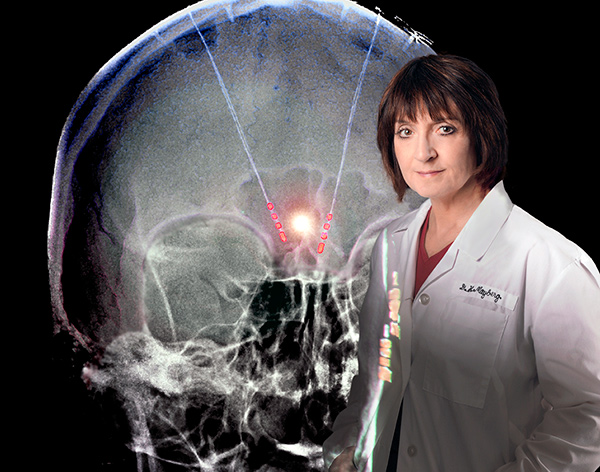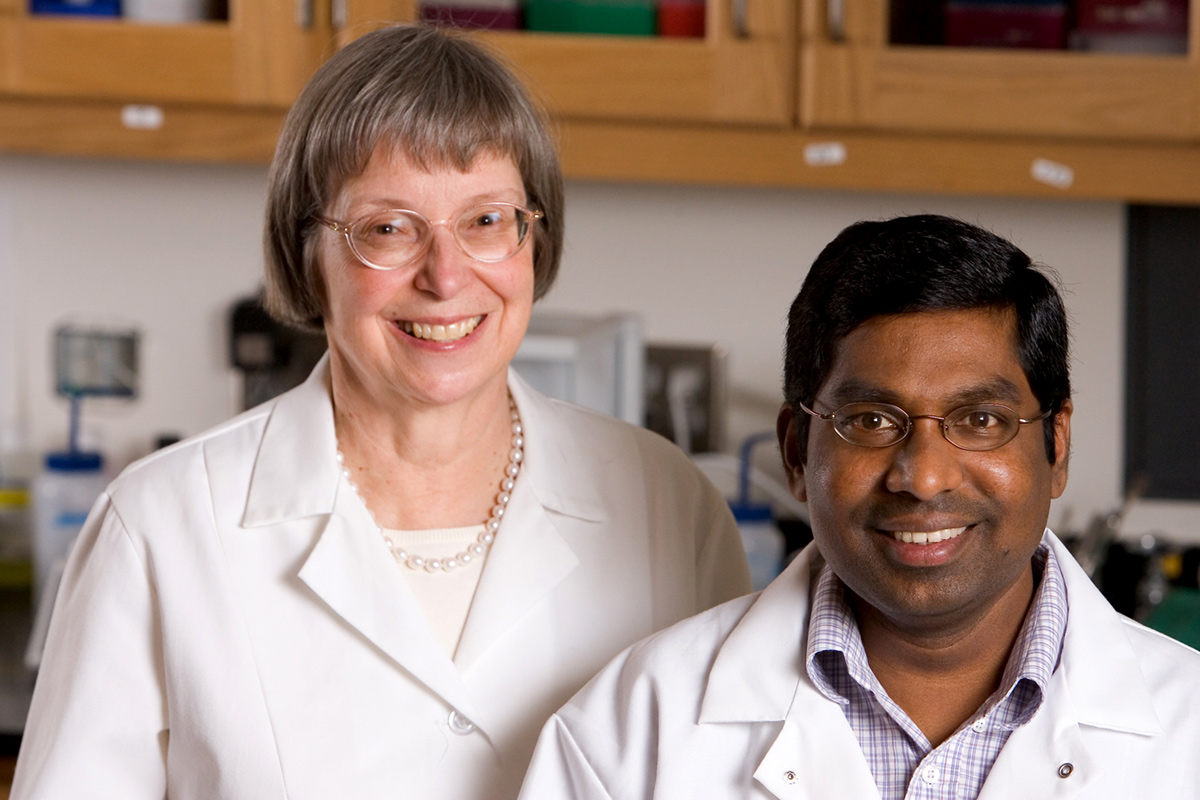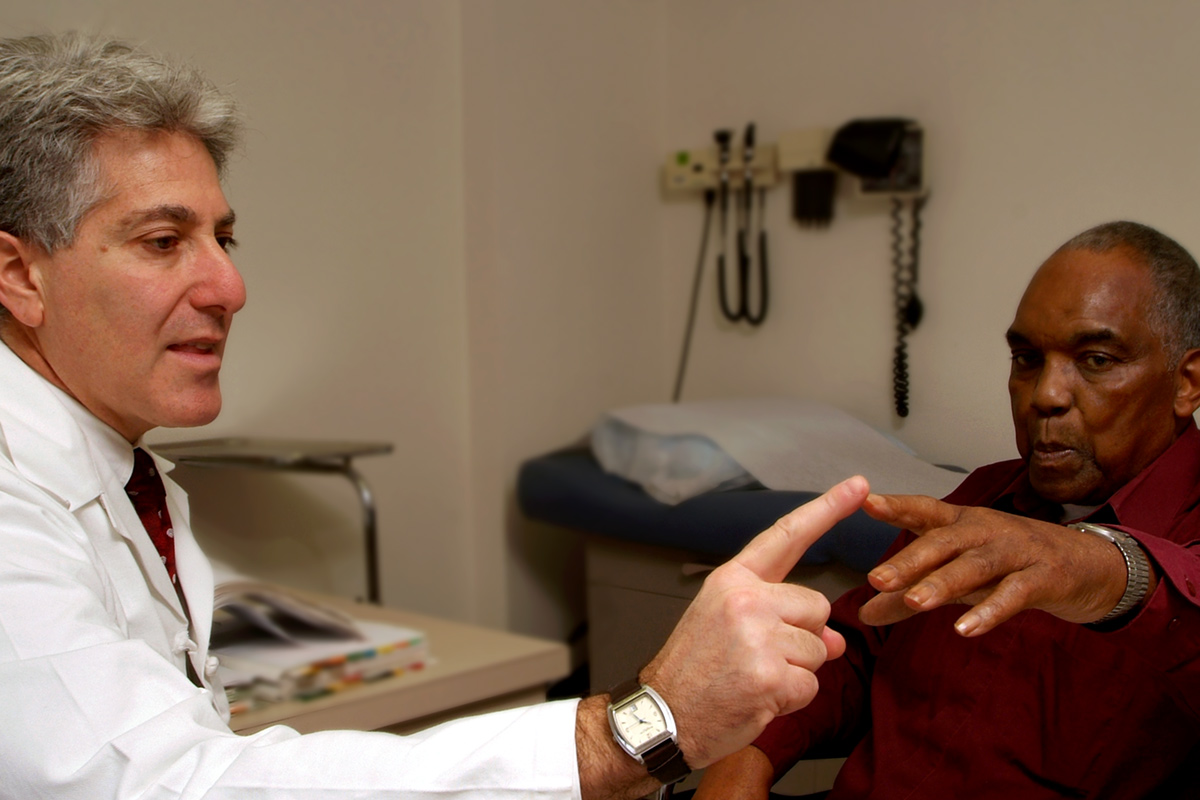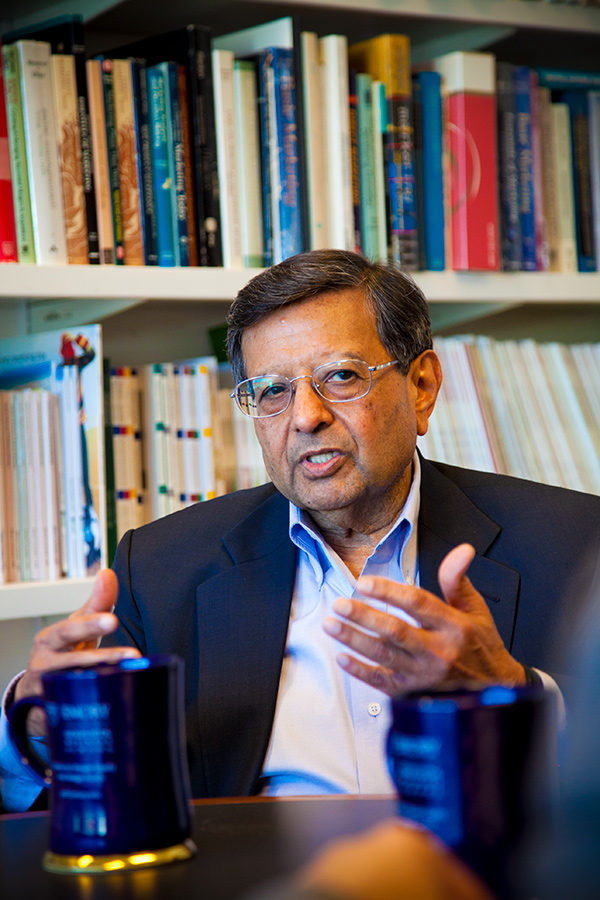Homegrown Discovery

Photo courtesy Virtually Better
63. To Market
In the past 10 years alone, Emory researchers have made 1,418 invention disclosures and applied for 968 patents. With help from the Office of Technology Transfer, Emory has seen 32 products reach the market and launched 55 start-up companies.
66. DNA Detective
Mitochondrial DNA, the smallest chromosome, was first linked to human disease by former Emory geneticist Douglas Wallace, who in 1988 found that a form of blindness is caused by mitochondrial gene mutations. He went on to link such mutations to Parkinson’s, Alzheimer’s, muscular dystrophy, some forms of epilepsy, heart disease, and adult-onset diabetes.
67. Defeating Depression

From breeding generations of depressed mice to creating personalized therapies, Emory research on the most common psychiatric disorder—clinical depression—is having a measurable impact. One of many success stories: neurologist Helen Mayberg and colleagues studied the effects of deep brain stimulation in patients with major depression who were resistant to other treatments; most reported lasting improvement.
68. Heart in 3-D
Thousands of doctors around the world use Syntermed’s Emory Cardiac Toolbox, nuclear imaging software invented by radiology professor Ernest Garcia, which displays a three-dimensional image of a patient’s heart and shows blood flow and efficiency, allowing for more accurate diagnosis of potential heart failure.
Harriet Robinson with fellow HIV/AIDS researcher Rama Amara in their Yerkes lab.
72. HIV Vaccine?
One of the leading AIDS vaccine candidates was discovered in microbiologist Harriet Robinson’s lab at the Emory Vaccine Center at Yerkes. Robinson, now chief scientific officer at the biotech startup GeoVax, says the DNA-based vaccine plus MVA (pox virus) booster first showed good results in rhesus macaque monkeys and is now proving safe and producing good immune responses in humans. Robinson was one of the first scientists to demonstrate that purified DNA could be used as a safe and effective vaccine.
73. AIDS Buster
An estimated 94 percent of US patients and thousands more globally on antiretroviral therapy take drugs based on compounds discovered at Emory.
74. Safe Water
About 5,000 children die each day from diseases linked to unsafe water, according to the World Health Organization, and about a billion people in the world lack drinkable water. “Every public health intervention is affected by access to safe water,” says former CDC scientist and professor emeritus Eugene Gangarosa, who helped develop the Safe Water System, which combines treatment using diluted bleach and smart storage in narrow-mouthed containers with lids. Gangarosa and his wife, Rose, established chairs in safe water and sanitation at the Rollins School of Public Health. The Center for Global Safe Water at Rollins is a landmark partnership among Emory, CARE USA, and the CDC to improve universal access to safe water.

Alzheimer's center director Allan Levey with a patient.
75. Alzheimer’s Boom
Researchers across Emory are racing the clock to find better treatments and medications for Alzheimer’s before the baby boomer cohort develops the devastating disease in epidemic proportions. In 2010, the Emory Alzheimer’s Disease Research Center again received the National Institute on Aging’s prestigious designation (one of 30 in the US and the only one in Georgia) along with $8 million in funding.

Illustration courtesy the Center for the Study of Law and Religion
76. Taboo Topics
Tackled The societal intersections where law and religion meet, merge, and sometimes clash are explored in the writings and lectures of the Center for the Study of Law and Religion (CSLR) scholars. Based in the School of Law, the CSLR organizes public forums, research, and publication around such topics as human rights, the pursuit of happiness, and the child in society. Founded by President James Laney and Professor of Law Frank Alexander three decades ago, the center rose to international prominence with its 1991 conference on Christianity and democracy, bringing together 800 participants from five continents and featuring keynote addresses from former US President Jimmy Carter and Anglican Archbishop Desmond Tutu. “We focus our research and teaching on the fundamentals of faith, freedom, and the family,” says CSLR director and Jonas Robitscher Professor of Law John Witte, “—the three things for which people will die.”
77. Numbers Sleuths
On a hike in the north Georgia forest, Emory mathematicians Ken Ono and Zach Kent experienced a breakthrough that shed light on one of the oldest mathematical mysteries: the nature of partition numbers. By pretending to “walk” amid the numbers, the researchers realized that they behave like fractals, infinitely repeating complex patterns.
78. They’ll Kill You
As Emory’s new tobacco-free campus policy becomes effective this fall, some have jokingly asked if the cigar held by Robert Woodruff’s statue in front of the main library will be removed. But Emory has long denounced the dangers of tobacco: one of the first voices to openly declare cigarettes as a cause of cancer was Elliott Scarborough, Winship Cancer Institute’s first director. Antismoking efforts and education continue, from the Rollins School of Public Health’s Tobacco Technical Assistance Consortium, funded with tobacco settlement money, to Emory Global Health Institute Director Jeff Koplan’s work with China to reduce its population’s high smoking rate.

79. Aping Our Ancestors
Empathy with the emotions of others is commonly associated with humans, but our primate cousins—like the gentle, peace-loving bonobo—demonstrate a remarkable capacity for caretaking and compassion. Evolution, it seems, has led us to care for one another not because it is a highly civilized behavior, but because it’s in our best interest. Then again, when we get angry, the aggressive urge to fight and dominate one another is in our DNA, too—as well as that of the chimpanzee, also one of our closest evolutionary relatives. Frans de Waal, Candler Professor of Primate Behavior and director of the Living Links Center at the Yerkes National Primate Research Center, is among the world’s most renowned scholars of nonhuman primates. Through more than a dozen books and hundreds of articles, he and fellow researchers have used the study of apes to hold up a mirror to humanity, helping us understand how our biological past shapes our behavior of the present.

Mahlon DeLong
80. Parkinson’s Progress
It’s long been known that Parkinson’s disease is caused by degeneration of the dopamine neurons in the basal ganglia, but in the early 1990s, Professor of Neurology Mahlon DeLong made the breakthrough discovery that this deficiency sets off a destructive chain reaction in other neurons that impairs motor and speech abilities. Tiny electric probes and deep brain stimulation have since been used to eliminate the malfunctioning neurons. The comprehensive Emory Udall Parkinson’s Disease Research Center is one of just a dozen in the US.
81. Meditation Goes Mainstream
The ancient practice of meditation has long had cachet on the new-age fringe, but a number of ongoing Emory studies indicate that it may have surprising health benefits. Researchers in the Emory Collaborative for Contemplative Studies, a component of the Emory-Tibet Partnership led by faculty members including Charles Raison and Geshe Lobsang Tenzin Negi, have found that compassion meditation may reduce stress, alleviate depression, and increase empathy, leading to better overall health.
82. Miracle Hormone?
Asa Candler Professor of Emergency Medicine Don Stein and colleagues are exploring the effect of progesterone on patients with traumatic brain injury and finding that outcomes are dramatically improved.
83. Jewish Studies
The Rabbi Donald Tam Institute for Jewish Studies has explored the complexities of Jewish civilization and culture since 1999. A $5 million challenge gift from Atlanta Falcons owner and Emory trustee Arthur Blank in 2001 allowed it to leap to the forefront of Jewish scholarship in the US with new faculty appointments, endowed chairs, degree programs, and a lecture series.

Stephanie Sherman
84. The X Factor
An international research team led by Emory geneticist Stephen Warren in 1991 discovered the FMR1 gene, which is responsible for fragile X syndrome, the most common inherited form of mental retardation. Later, Emory geneticist Stephanie Sherman, who studies the inheritance patterns of fragile X, noted that the effects of the mutation seem to worsen with each passing generation—a finding now known as the Sherman Paradox. Emory’s fragile X syndrome clinic serves children with the syndrome and their families.
87. Faulkner Find
Sally Wolff King 79G 83PhD had been studying the literature of William Faulkner for three decades when she made a startling discovery about its origins. In 2008, Wolff King was interviewing Edgar Francisco III 56G and his wife, Anne Salyerds Francisco 54G, about their family’s relationship with the Southern writer—Edgar’s father and Faulkner grew up together in Mississippi—when Edgar brought out a massive tome of farm journals kept by his great-great grandfather, a wealthy plantation owner in the 1800s. As it turned out, the diary almost certainly served as inspiration for a number of characters and details in well-known Faulkner works. Wolff King’s article in the Southern Literary Journal and subsequent book created ripples among scholars. “To me,” she said, “it seems that he was sympathetic with the slaves and their plight, and by resurrecting their names . . . he memorialized them.”
88. Embrace the East

Jagdish Sheth
American business leaders fret over competition from China and India, but a Goizueta Business School expert says they should relax and open their minds—and markets. Even as “Chindia”—as Jagdish Sheth, Charles H. Kellstadt Professor of Marketing and author of Chindia Rising, calls it—builds its production capacity to give US industry a run for its money, those countries are also opening up their domestic consumer markets, where there are billions of potential buyers eager for American stuff. There’s just one catch, Sheth cautions—they don’t have much money. So companies that focus on making popular products cheaper will win. Which, considering the economy, might not be such a bad thing for American buyers, either.
102. Helping Transplants Take
The drug belatacept, which Emory researchers helped develop, has been shown to prevent graft rejection in kidney transplant recipients while better preserving kidney function.
104. Nursing New Life
In rural Ethiopia, as in many developing countries where most births still take place at home, childbirth is a matter of both life and death. The risk of mothers dying during birth is one in 27 and the infant mortality rate is 77 per 1,000 births. Associate nursing professor Lynn Sibley, a nurse-midwife and anthropologist who cowrote the American College of Nurse-Midwives’ manual Home-Based Life Saving Skills, is working to improve these odds with an $8.16 million grant from the Bill and Melinda Gates Foundation, the single-largest grant ever awarded to the School of Nursing. Partnering with the Ethiopian Ministry of Health, Sibley and others are creating community-based strategies to improve maternal and newborn health.
105. Slave Ships

More than 10 million Africans were forcibly transported on ships to the Americas between the 16th and 19th centuries to be sold as slaves. The Trans-Atlantic Slave Trade Database, a Digital Library Research Initiative that draws and expands on the collaborative work of slavery scholars around the world, makes information on almost 35,000 slaving voyages freely available on the Internet. The database includes trade routes, ship logs, and manifests, and identifies more than 67,000 enslaved passengers by name, age, gender, origin, and place of departure.
Click here to continue reading.
Our next category of note: The Common Good.






